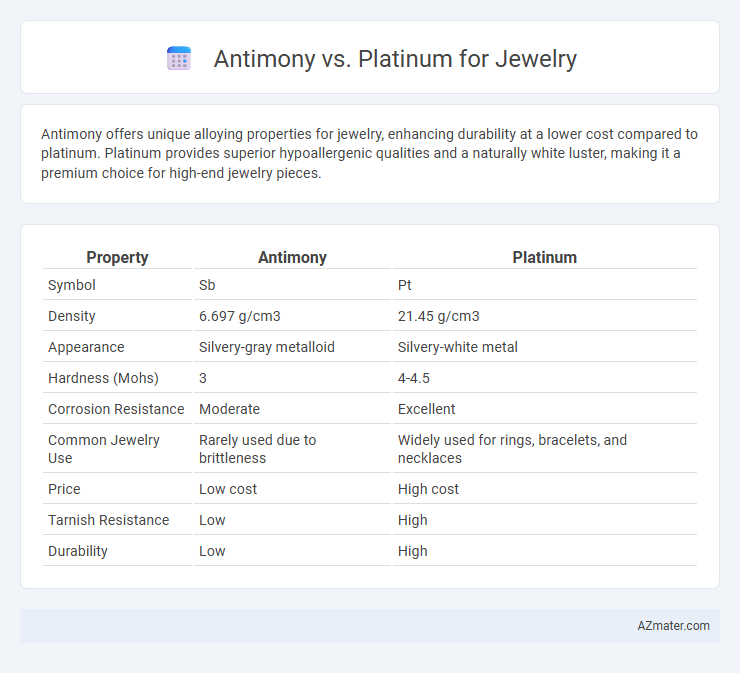Antimony offers unique alloying properties for jewelry, enhancing durability at a lower cost compared to platinum. Platinum provides superior hypoallergenic qualities and a naturally white luster, making it a premium choice for high-end jewelry pieces.
Table of Comparison
| Property | Antimony | Platinum |
|---|---|---|
| Symbol | Sb | Pt |
| Density | 6.697 g/cm3 | 21.45 g/cm3 |
| Appearance | Silvery-gray metalloid | Silvery-white metal |
| Hardness (Mohs) | 3 | 4-4.5 |
| Corrosion Resistance | Moderate | Excellent |
| Common Jewelry Use | Rarely used due to brittleness | Widely used for rings, bracelets, and necklaces |
| Price | Low cost | High cost |
| Tarnish Resistance | Low | High |
| Durability | Low | High |
Introduction to Antimony and Platinum in Jewelry
Antimony is a metalloid rarely used in jewelry due to its brittleness and toxicity, mainly serving as an alloying element to improve hardness and durability in metal blends. Platinum is a precious metal highly valued in jewelry for its exceptional luster, hypoallergenic properties, and resistance to tarnish and corrosion, making it ideal for fine rings and luxury pieces. The choice between antimony and platinum significantly affects jewelry's durability, appearance, and value, with platinum being the preferred material for high-end, enduring designs.
Physical Properties: Antimony vs Platinum
Antimony is a brittle metalloid with a relatively low melting point of 631degC and poor ductility, making it unsuitable for intricate jewelry designs. Platinum, a dense and malleable metal with a melting point of 1,768degC, offers exceptional durability and resistance to tarnishing, ideal for fine jewelry. The significant difference in hardness and malleability between antimony and platinum clearly favors platinum in crafting long-lasting, high-quality jewelry pieces.
Appearance and Aesthetic Qualities
Antimony is a lesser-known metal with a dull gray hue and a matte finish, often used in alloys rather than jewelry alone, offering limited luster and aesthetic appeal compared to precious metals. Platinum stands out with its brilliant white sheen, exceptional brilliance, and naturally hypoallergenic qualities, making it highly desirable for fine jewelry. Its dense, durable nature combined with a lustrous finish provides an elegant and sophisticated appearance that enhances gemstone settings.
Durability and Wear Resistance
Platinum exhibits superior durability and wear resistance compared to antimony, making it a preferred choice for fine jewelry exposed to daily wear. Antimony, primarily used as an alloying element or in decorative coatings, lacks the hardness and resilience of platinum, which maintains its luster and structural integrity over time. Platinum's high density and resistance to scratching and tarnishing ensure it withstands the rigors of everyday use better than antimony-based materials.
Hypoallergenic Features and Skin Safety
Antimony is rarely used in jewelry due to potential skin irritation and allergenic reactions, whereas platinum is highly valued for its hypoallergenic properties and excellent skin safety. Platinum's inert nature prevents allergic responses, making it ideal for sensitive skin, while antimony alloys can release irritant ions that cause dermatitis. Jewelry made from platinum ensures long-term wear without triggering allergies, contrasting with the higher skin safety risks associated with antimony-containing pieces.
Cost Comparison: Antimony vs Platinum
Antimony jewelry is significantly more affordable than platinum due to the lower cost of antimony as a raw material and simpler manufacturing processes. Platinum is one of the most expensive precious metals, with prices often exceeding $30 per gram, compared to antimony, which costs less than $1 per gram in raw form. The high cost of platinum results in jewelry pieces that are durable and high-value, while antimony offers a budget-friendly alternative with limited durability.
Workability and Design Flexibility
Antimony, a brittle metalloid, offers limited workability and is rarely used alone in jewelry, primarily serving as an alloying element to enhance hardness and durability; its rigidity restricts intricate designs. Platinum, a dense and malleable precious metal, excels in workability, allowing jewelers to create detailed and complex designs with high precision while maintaining strength and resistance to tarnish. The superior ductility and flexibility of platinum significantly expand design possibilities compared to antimony-based materials, making it the preferred choice for fine jewelry craftsmanship.
Environmental and Ethical Considerations
Antimony mining often raises significant environmental concerns due to toxic waste production and habitat disruption, while platinum extraction is energy-intensive but more closely regulated in many regions. Ethically, platinum benefits from established recycling programs and stricter labor standards, reducing exploitation risks, whereas antimony mining is frequently linked to poor labor conditions and limited oversight. Consumers seeking sustainable jewelry should prioritize platinum for its relatively lower environmental impact and better ethical sourcing practices.
Popular Uses in Jewelry Trends
Antimony is rarely used in jewelry due to its toxicity and brittleness, whereas platinum remains a highly popular choice for fine jewelry, especially in engagement rings and wedding bands, due to its durability, hypoallergenic properties, and lustrous appearance. Recent jewelry trends emphasize platinum's role in minimalist and contemporary designs, appreciated for its ability to securely hold precious stones like diamonds and sapphires. Antimony, primarily used as an alloying agent in metals rather than a standalone material, does not feature prominently in mainstream or designer jewelry markets.
Conclusion: Choosing Between Antimony and Platinum
Choosing between antimony and platinum for jewelry depends on durability, appearance, and hypoallergenic properties. Platinum offers superior strength, resistance to tarnish, and a naturally white luster ideal for high-end pieces, while antimony is more affordable but less durable and prone to corrosion. Prioritizing long-term value and skin safety, platinum remains the preferred choice for fine jewelry.

Infographic: Antimony vs Platinum for Jewelry
 azmater.com
azmater.com